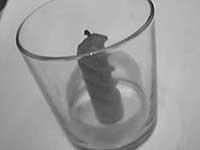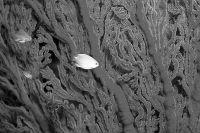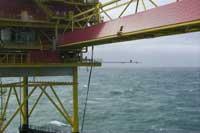Source of bicarbonate
2001/02/01 Ares, Felix Iturria: Elhuyar aldizkaria

This department has had its place until now in Gaztelhuar, but as you have already noticed, Gaztelhuyar is no longer published on paper, since from now on it will make its way on the Internet. The Learn Playing section jumps to the big magazine and begins its new path in this issue. This page will show a simple monthly experiment, which anyone can access to understand the basics of science. Let it be for everyone's enjoyment!
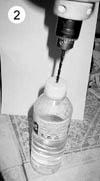
The task of February is very simple: build a fountain from a bottle of water. The ones you need for this experiment are one of these plastic bottles for water or gas drinks, a plastic straw, a drill, a drill of the same thickness of the straw, a bit of glue, a bit of sodium bicarbonate (bicarbonate) and a vinegar.
In the search for bits of the same thickness or diameter of the straw, you can use the caliber or, if not, pair them and consider them of the same magnitude (see figure 1).
Place the drill bit in the drill and make the hole in the center of the bottle cap (see figure 2). Put the straw in the hole, leaving two or three centimeters outside. Any slit that is closed later. To do this, the adhesive is placed in the bonding area of the straw and the stopper, both from the outside and from the inside of it (see figures 3 and 4). Wait for the adhesive to dry completely.

Fill the 3/4 of the bottle with water and add three or four tablespoons of vinegar and then a tablespoon of baking soda (baking soda used to make cakes or pastries and muffins). You will find that almost suddenly bubbles will form in the liquid. You should put the cap you have prepared to the bottle as fast as you can and you will see that the water begins to rise and leaves the straw with some force (see figure 5).

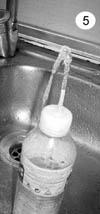
The explanation is as simple as the experiment. Vinegar to water and bicarbonate react to each other. Vinegar is an acid and bicarbonate is a base, both at the same time give an acid/base reaction, which causes the formation of carbon dioxide gas in the bottle (therefore bubbles). Carbon dioxide makes the bottle pressure higher than the room pressure. As nature tends to balance, it will tend to equalize the pressure in the room and in the bottle, the carbon dioxide will come out through the straw (single outlet) and with it the water.

Gai honi buruzko eduki gehiago
Elhuyarrek garatutako teknologia




